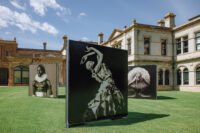
Artists reflect on their PHOTO 2024 Open Call experience
16.1.25
We asked Fiona Amundsen, Adam Ferguson, Asafe Ghalib, Kaya and Blank and Karabo Mooki about presenting their work for PHOTO 2024, and being selected through the festival's Open Call.
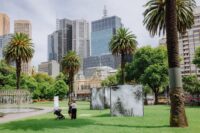
Fiona Amundsen, Blowing In The Wind, PHOTO 2024 Installation View. Photo: Will Hamilton-Coates
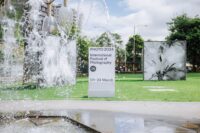
Fiona Amundsen, Blowing In The Wind, PHOTO 2024 Installation View. Photo: Will Hamilton-Coates
Fiona Amundsen (NZ)
Hi Fiona! Can you tell us about your work and how it was presented for PHOTO 2024?
I exhibited a series of photographs that are part of a larger body of work titled Blowing in the Wind, which explores the impact of fifty years of colonial inflicted nuclear weapons testing and ongoing militarisation across Moana-Oceania. The exhibited photographs were taken in Guåhan (Guam)—who is fighting for compensation regarding exposure to downwind radiation caused by US testing in the Marshall Islands—and Tinian Island, which was the departure point for the planes that carried and dropped the first, and only, nuclear weapons used in combat. The photographs were processed on location with seawater containing trace residues of radiation which fogged the light-sensitive film.
In addition, during the film development, chemiluminescence has been added, impacting the image embedded in the film’s light-sensitive emulsion. Chemiluminescence is a process used in ‘Western Blot’ DNA testing. In this context, chemiluminescence damages the film by creating white spots of fogging. This process is akin to how radiation resides in the body’s DNA, damaging it over time. Ultimately, these photographs are driven by my interest in and commitment to transgenerational nuclear justice.
Q. What did it mean for you to have your work exhibited outdoors?
My works were shown in the Parliament Gardens on large free standing three-sided frames. Due to their size, they were visible from quite some distance.
It was amazing to see my work at such a large scale, and for it to exist in a way that was free standing and ‘in’ space, if that makes sense. Also, I was conceptually drawn to exhibiting in Parliament Gardens due to the political context my photographs explore. It felt politically significant to exhibit these photographs near Parliament House, which is a site that is representative of much of the settler-colonial and imperial ideology that Blowing in the Wind is critiquing, albeit within the context of nuclear weapons manufacturing and testing.
Q. What were your highlights of participating in PHOTO 2024?
It was humbling to exhibit alongside such an incredible selection of artists who are all, in some way, concerned with not just the ‘future’, but what it looks like, meaning how to see and recognise it. I felt proud to have my work shown within the same exhibition as artists that I admire. I am grateful for the opportunity and for the critical and conceptual photography-driven dialogues that PHOTO 2024 enabled my work to be part of.
Q. What advice do you have for anyone thinking of applying for PHOTO 2026?
I suggest thoroughly researching the PHOTO 2026 conceptual theme and then to use those findings to laterally explore how your work can align. In other words, use the theme as mechanism by which to take risks in not just your practice, but how you language, think and conceptualise it. In addition, take risks and be ambitious! Start from the position of ‘if I could do anything…’
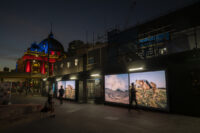
Adam Ferguson, Big Sky, PHOTO 2024 Installation View. Photo: Will Hamilton-Coates
Adam Ferguson (AU)
Q. Hi Adam! Can you tell us about your work and how it was presented for PHOTO 2024?
For PHOTO 2024, I exhibited my decade long project – Big Sky. It’s a photographic survey of Australia’s heartland, my ode to the Australian bush. The work is an attempt to challenge and position archetypal tropes of Australian identity with the complex realities of contemporary life in the Outback, and the future of this changing landscape. It was presented across two screens in Federation Square that rolled a slideshow of images from our arid interior.
Q. What did it mean for you to have your work exhibited outdoors?
Art can often be an exclusive dialogue, but making it public deconstructs that. My photos of rural youth and pastorism, mining, climate change and Indigenous Australia were presented to foot traffic to engage with serendipitously. I enjoyed witnessing people witness my work who weren’t looking for it. Public art is a great way to stimulate dialogue in spaces where it may not have occurred.
What were your highlights of participating in PHOTO 2024?
Having my work recognised and exhibited by PHOTO 2024 was a huge honour. It has helped my project expand into other worlds and audiences. It’s also helped me connect with the other artists and participate in a broader photographic community, both in Australia and abroad.
What advice do you have for anyone thinking of applying for PHOTO 2026?
Make work or submit a series that subverts photography made historically. Audiences are looking for images that you haven’t seen before, so it’s important to find new ways of exploring personal narratives. Sounds simple of course.
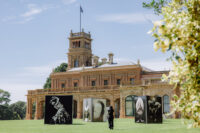
Asafe Ghalib, Queer Immigrants, PHOTO 2024 Installation View. Photo: Will Hamilton-Coates
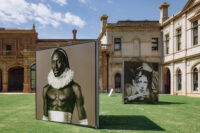
Asafe Ghalib, Queer Immigrants, PHOTO 2024 Installation View. Photo: Will Hamilton-Coates
Asafe Ghalib (BR)
Can you tell us about your work and how it was presented for PHOTO 2024?
My work Queer Immigrants aims to capture moments of people within an historical context in order to bring awareness to the long-resisting and historically mis-represented Queer community.
For PHOTO 2024, this work was presented at the Werribee Park Mansion, a perfect setting for this exhibition. The sprawling garden surrounding the mansion served as a breathtaking backdrop, enhancing the impact of the photographs. It was truly a magical and emotional experience to witness my work on such a grand scale, amidst the beauty of nature.
What did it mean for you to have your work exhibited outdoors?
As an artist, I never imagined how my work would be displayed. I approach my creative process with intentions and a purpose to deliver something meaningful to the world. However, seeing my work displayed outdoors as an installation, integrated into the surrounding environment, was truly mesmerising and inspiring. It provided a new perspective and a fresh interpretation of my artwork, almost giving it a new life.
What were your highlights of participating in PHOTO 2024?
The experience of witnessing the work of such talented artists throughout the city was truly incredible. What made it even more special was the opportunity to meet these artists in person and forge friendships with them. One artist in particular, J Davies, stood out with their stunning work. The reception from the Artistic Director, Elias Redstone, and the Curator, Brendan McCleary, was exceptional. They took great care of us throughout the journey, making it a truly beautiful experience.
What advice do you have for anyone thinking of applying for PHOTO 2026?
Being true to your body of work is not just about creating something novel or different for the sake of it. It’s about tapping into your authentic self and allowing that to guide you towards a more insightful, thought-provoking, and meaningful engagement with the world you are trying to convey. It’s about using your creative voice to share your distinct perspective and, in the process, inspire others to see the world through a lens they may never have considered before.
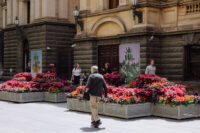
Kaya and Blank, Second Nature, PHOTO 2024 Installation View. Photo: Will Hamilton-Coates
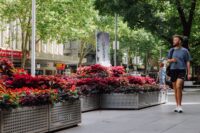
Kaya and Blank, Second Nature, PHOTO 2024 Installation View. Photo: Will Hamilton-Coates
Kaya and Blank (TR/DE)
Hi Kaya and Blank! Can you tell us about your work and how it was presented for PHOTO 2024?
Our project Second Nature focuses on cell towers disguised as trees across Southern California. These camouflaged structures reflect a strange relationship between technology and nature, blending into the environment while serving as critical infrastructure. For PHOTO 2024, the photographs were presented outdoors in front of the Melbourne Town Hall, incorporated into planters filled with beautiful plants. The arrangement created a striking juxtaposition, where our photos of fake trees blended in with real, living plants. This installation added a new layer of meaning to the project, allowing the audience to experience it in a tangible way.
Q. What did it mean for you to have your work exhibited outdoors?
Having Second Nature exhibited outdoors with plants was particularly meaningful. The photographs are of outdoor structures, so placing them in an outdoor setting made perfect sense. The planter installation not only complemented the work but expanded the conversation about our relationship with nature in an urban environment. Seeing how our work interacted with its surroundings in such a central location in Melbourne was special, and the outdoor presentation added a depth of context that a traditional gallery setting might not have been able to provide.
Q. What were your highlights of participating in PHOTO 2024?
One major highlight was the opportunity to exhibit in Australia, a country we had never shown our work in before. Although we couldn’t attend in person, we received many impressions and had wonderful conversations with viewers through social media. The visibility of our work in such a central, public space allowed for a diverse audience to engage with it, sparking dialogues we hadn’t anticipated. Additionally, the exhibition team did an incredible job installing the work in such a thoughtful way—it was a privilege to see how carefully they integrated our photographs into the space.
Q. What advice do you have for anyone thinking of applying for PHOTO 2026?
Our advice would be to consider how your work can interact with public or nontraditional spaces. We encourage artists to embrace opportunities to exhibit outside the usual gallery walls and to think creatively about how their work might engage with diverse audiences in different environments. And most importantly—apply! It’s an incredible platform with a global reach that truly values artistic vision.

Karabo Mooki, from the series AMANDLA, PHOTO 2024 Installation View. Photo: Will Hamilton-Coates
![_MG_1278 Karabo Mooki, from the series [AMANDLA], PHOTO 2024 Installation view, Photo courtesy Karabo Mooki](https://photo.org.au/api/wp-content/uploads/2024/10/MG_1278-133x200.jpg)
Karabo Mooki, from the series AMANDLA, PHOTO 2024 Installation View. Photo: Karabo Mooki
Karabo Mooki (ZA)
Can you tell us about your work and how it was presented for PHOTO 2024?
The body of work that I exhibited with PHOTO 2024 is an analogue photo story that explores the lives of a community built by Black women in skateboarding.
The young women in this series are pushing borders, and gaining greater recognition within skateboarding by reclaiming their right to appear in the places they skate. Also declaring their rights in protest to South Africa’s tumultuous history of gender-based violence.
These photographs are a visual documentation of the lives of a community in skateboarding, made up of a tight knit crew of women and queer identities. Safety and strength comes from a mutual, shared vulnerability in parallel with facing power relations found in public spaces. The dynamic agency of the group extends beyond their representation in images through action and agency created by forming new group dynamics across genders and experiences as sites of resistance.
In a time where taking up space is crucial for change to develop, confronting conversations about gender based violence must be addressed. These skateboarders are pushing for revolution.
What did it mean for you to have your work exhibited outdoors?
The curation of the festival and having the opportunity to have my work exhibited outdoors complimented the theme of the work hugely, allowing the work to celebrate the themes that are centered around visibility and inclusion. The outdoor exhibition invites the general public to engage and interact with the message of the community that I have documented and informs those who may have not been aware of the changes that are happening in contemporary youth culture in South Africa. Having the work outdoors in public space meant the world to me as it allows those who are intimidated by traditional gallery space an opportunity to observe and absorb art with comfort and curiosity.
What were your highlights of participating in PHOTO 2024?
I believe every single moment I was there revealed world class hospitality, an invested interest in helping artists connect with prominent figures, from curators, gallerists to artists I could only dream of being in the same room as. Every component of the festival is carefully curated to support artists participating and I found this was by far the greatest experience I’ve had with any photo festival globally.
What advice do you have for anyone thinking of applying for PHOTO 2026?
Do not hesitate to give it a shot. Embrace the magic and if you can try to make it out to the festival, the celebration of art and the message of each artist’s work is world class, being in attendance physically is an unforgettable experience.
_______________________________________
Apply now for the PHOTO 2026 Open Call.
The 2026 Open Call is powered by Picter.
_______________________________________